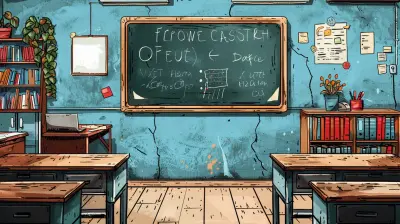E-Learning for K-12: How to Keep Younger Learners Engaged
26 July 2025
Let’s face it — keeping kids focused on a screen for any length of time can feel like herding cats. And when it comes to e-learning for K-12 students, the stakes are even higher. Distance learning has opened up a world of possibilities, but it also brings new challenges, especially when we’re trying to hold the attention of curious little minds that would rather be doing anything else.
So, how do you make sure your students or children actually want to show up and participate in an online class? That’s the big question we’re going to tackle today. Whether you’re a teacher, parent, or school administrator, this guide will give you practical, real-world strategies to keep those young learners engaged and excited to learn — even from behind a screen.
Why Engagement Is the Game-Changer in K-12 E-Learning
We all know kids have short attention spans. One minute they’re all in, the next they’re building a LEGO tower under the table. That’s totally normal. But in an online learning environment, where teachers can’t physically walk around a classroom, spotting those drifting minds is a whole lot harder.That's why engagement isn’t just a “nice-to-have” — it’s a must. Without it, all the effort you put into lessons could go unnoticed. Engaged students are more likely to retain information, participate actively, and actually enjoy learning.
So, how do we crack the engagement code?
1. Mix It Up With Interactive Content
Ever sat through a boring webinar? Imagine how that feels for a 7-year-old. Now multiply that by ten.Kids crave variety. So instead of making them stare at slides or listen to lectures, get them involved! Here’s how:
- Quizzes and Polls: Tools like Kahoot or Quizizz turn learning into a game.
- Virtual Whiteboards: Let them draw, doodle, or solve problems in real-time using tools like Jamboard.
- Group Challenges: Break kids into small groups and give them fun tasks. Think of it as online group work — but without the groans.
And don’t forget, the more senses you engage, the better. Use visuals, sounds, and even physical objects at home to make the lesson pop.
2. Keep Lessons Short and Sweet
You know how your brain checks out during a long meeting? Same deal for kids.For younger learners, aim for bite-sized lessons. Something like:
- 10–15 minutes of instruction
- 5–10 minutes of interactive activity
- A few minutes of discussion
Chunk the lesson into smaller sessions and take micro-breaks in between. Even a 60-second stretch or dance party can do wonders.
Think of it like giving the brain a breather — a little reset that helps kids refocus.
3. Use Gamification to Your Advantage
Kids love games. It’s in their DNA. So why not turn learning itself into a game?Gamification adds layers of fun by:
- Offering points for completed tasks
- Giving out badges or certificates
- Showing progress bars so they can see how far they’ve come
Platforms like ClassDojo or Minecraft Education Edition bring this to life.
When kids know they’re working toward a reward — even a digital sticker — it creates motivation. It’s like leveling up in a video game but with math, reading, or science!
4. Let Kids Be Themselves
Think about it — kids aren’t robots, and learning isn’t “one size fits all.”Some love speaking up. Others prefer typing in the chat. Some might want to draw their answers. Give them room to express themselves in different ways.
A few ideas:
- Allow video or audio submissions instead of written ones
- Let them choose topics for projects
- Use open-ended questions to spark creativity
When students feel like their personality is part of the learning process, they’re more likely to stick around and engage.
5. Create a Safe and Supportive Virtual Space
Learning thrives in a positive space — even online.Kids need to feel seen and heard. They need to feel like it’s okay to make mistakes. Here’s how you can build that vibe:
- Start each day with a quick check-in — a silly question or a fun fact
- Celebrate effort, not just perfection
- Set clear expectations for behavior in class and stick to them
When students know what’s expected and that they won’t be judged, they’ll be more open to participate. Kindness really goes a long way here.
6. Encourage Parent Involvement (Without Overload)
Let’s be honest — when it comes to younger kids, parents are part of the learning equation, like it or not.But here’s the deal: they’re probably juggling work, house chores, and their own stress. So instead of asking them to become full-time teachers, keep it simple:
- Send weekly emails with tips on how they can help
- Provide easy-to-follow instructions for homework or tech tools
- Offer office hours or Q&A sessions just for parents
When parents feel supported, they’re more likely to support you — and their child’s learning too.
7. Incorporate Real-World Learning
Nothing beats the excitement of learning something you can actually use. Younger kids love it when school feels like an adventure.Try things like:
- Cooking for math (fractions, measurements)
- Gardening for science (plant life cycles)
- Storytelling through video (creative writing + tech)
This hands-on learning connects the digital world to their real-life experiences. It’s like bringing the classroom into the living room.
8. Use Technology Thoughtfully
Yes, tech is amazing. But let’s not go overboard.The goal isn't to use all the apps, it’s to use the right ones. Find tools that meet these must-haves:
- Easy to use (for kids and parents)
- Visually engaging
- Customizable for student needs
- Compatible across devices
And always have a Plan B — because sometimes tech fails. Wi-Fi goes down, platforms crash, and kids click the wrong thing. Be flexible and keep communication open.
9. Build Routines and Structure
Kids actually love structure (even if they act like rebels). Routines give them a sense of control and comfort.Try to:
- Keep a consistent daily schedule
- Start lessons with a welcoming ritual (like a good morning song)
- End with a wrap-up to reflect and preview what’s next
Consistency helps younger learners know what’s coming, and that predictability makes learning feel safe and inviting.
10. Be Present and Personable
Behind every effective online teacher is a real, approachable human being.So, show up. Smile. Use their names. Share stories. Laugh when things go wrong.
You don’t need to be perfect — kids love it when you're relatable.
Make it a two-way street. Ask them about their pets, hobbies, or favorite snacks. This human connection makes all the difference.
Final Thoughts: It’s About Making Learning Feel Like Play
Here’s the thing — young kids don’t separate “learning” from “playing.” To them, it’s all one big experiment. And that’s actually a good thing.When we tap into that natural curiosity, we unlock their brain’s best learning mode. All it takes is a bit of creativity, flexibility, and heart.
E-learning for K-12 doesn't have to be another Zoom meeting they dread. With the right approach, it can become an exciting part of their everyday routine — one that sparks imagination, builds skills, and keeps their love for learning alive.
So, next time you fire up that virtual classroom, ask yourself: “Am I teaching, or am I inviting them to explore?” Because when kids feel like they’re part of the journey, they’re in it for the long haul.
Bonus Tips: Quick Wins for Instant Engagement
Here’s a rapid-fire list of things you can try tomorrow:- Use background music during silent work time
- Give silly virtual gifts (like a “golden pineapple award”)
- Let kids take turns being “lesson helpers”
- Do theme days (pajama day, superhero day, etc.)
- Show short, catchy video clips to introduce topics
The smallest tweaks can lead to the biggest smiles. And remember — if you’re having fun, they probably are too.
all images in this post were generated using AI tools
Category:
E LearningAuthor:

Olivia Chapman
Discussion
rate this article
1 comments
Lacey Anderson
Is it just me, or does every kid have a secret superpower for dodging online lessons? Let’s sprinkle in some digital glitter, sprinkle in creativity, and watch their engagement soar higher than a cat in a laser pointer chase!
August 5, 2025 at 8:03 PM

Olivia Chapman
Absolutely! Adding creativity and interactive elements can definitely boost engagement and make online learning more enjoyable for kids!


